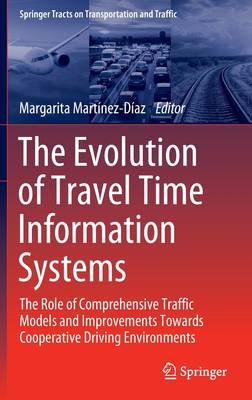
Door een staking bij bpost kan je online bestelling op dit moment iets langer onderweg zijn dan voorzien. Dringend iets nodig? Onze winkels ontvangen jou met open armen!
- Afhalen na 1 uur in een winkel met voorraad
- Gratis thuislevering in België vanaf € 30
- Ruim aanbod met 7 miljoen producten
Door een staking bij bpost kan je online bestelling op dit moment iets langer onderweg zijn dan voorzien. Dringend iets nodig? Onze winkels ontvangen jou met open armen!
- Afhalen na 1 uur in een winkel met voorraad
- Gratis thuislevering in België vanaf € 30
- Ruim aanbod met 7 miljoen producten
Zoeken
The Evolution of Travel Time Information Systems
The Role of Comprehensive Traffic Models and Improvements Towards Cooperative Driving Environments
€ 158,45
+ 316 punten
Omschrijving
This book deals with the estimation of travel time in a very comprehensive and exhaustive way. Travel time information is and will continue to be one key indicator of the quality of service of a road network and a highly valued knowledge for drivers. Moreover, travel times are key inputs for comprehensive traffic management systems.
All the above-mentioned aspects are covered in this book. The first chapters expound on the different types of travel time information that traffic management centers work with, their estimation, their utility and their dissemination. They also remark those aspects in which this information should be improved, especially considering future cooperative driving environments.Next, the book introduces and validates two new methodologies designed to improve current travel time information systems, which additionally have a high degree of applicability: since they use data from widely disseminated sources, they could be immediately implemented by many administrations without the need for large investments.
Finally, travel times are addressed in the context of dynamic traffic management systems. The evolution of these systems in parallel with technological and communication advancements is thoroughly discussed. Special attention is paid to data analytics and models, including data-driven approaches, aimed at understanding and predicting travel patterns in urban scenarios. Additionally, the role of dynamic origin-to-destination matrices in these schemes is analyzed in detail.
All the above-mentioned aspects are covered in this book. The first chapters expound on the different types of travel time information that traffic management centers work with, their estimation, their utility and their dissemination. They also remark those aspects in which this information should be improved, especially considering future cooperative driving environments.Next, the book introduces and validates two new methodologies designed to improve current travel time information systems, which additionally have a high degree of applicability: since they use data from widely disseminated sources, they could be immediately implemented by many administrations without the need for large investments.
Finally, travel times are addressed in the context of dynamic traffic management systems. The evolution of these systems in parallel with technological and communication advancements is thoroughly discussed. Special attention is paid to data analytics and models, including data-driven approaches, aimed at understanding and predicting travel patterns in urban scenarios. Additionally, the role of dynamic origin-to-destination matrices in these schemes is analyzed in detail.
Specificaties
Betrokkenen
- Uitgeverij:
Inhoud
- Aantal bladzijden:
- 289
- Taal:
- Engels
- Reeks:
- Reeksnummer:
- nr. 19
Eigenschappen
- Productcode (EAN):
- 9783030896713
- Verschijningsdatum:
- 22/01/2022
- Uitvoering:
- Hardcover
- Formaat:
- Genaaid
- Afmetingen:
- 156 mm x 234 mm
- Gewicht:
- 612 g

Alleen bij Standaard Boekhandel
+ 316 punten op je klantenkaart van Standaard Boekhandel
Beoordelingen
We publiceren alleen reviews die voldoen aan de voorwaarden voor reviews. Bekijk onze voorwaarden voor reviews.










